Lightning protection is not just our business. We find this natural phenomenon simply fascinating in general. In our monthly spotlight on the types of lightning, we’d be remiss if we failed to mention that our Clearwater Florida office is adjacent to Tampa – a town believed to actually be named for lightning.
Reputed to be called “Tanpa” by the Calusa, a Native American tribe, the word allegedly means “sticks of fire” in their language. If you have ever been delayed at Tampa International Airport, the light show you’d see from the tarmac makes the moniker quite apropos!
For an award-winning lightning show (according to The Guinness World Book of Records) you’d have to instead journey to the beautiful country of Venezuela for the Catatumbo River spectacle.
Known simply as “Catatumbo Lightning” it has been honored with the designation of the area with the most lightning; reported to receive up to 3,600 flashes per hour. Over the course of the year and its lightning season means those bolts number approximately 1.2 million per year.
According to Guinness in an email to The Huffington Post: “The Catatumbo Lightning occurs in Venezuela over the mouth of the Catatumbo River as it enters Lake Maracaibo. This area receives almost 250 lightning flashes per square kilometer each year. Lightning happens up to 300 nights per year in displays that can last nine hours. In 2010 the lightning ceased from January to April, possibly due to effects from the El Niño/La Niña–Southern Oscillation.”
What’s even more intriguing about Catatumbo Lightning is that it isn’t as much that it is a special type of lightning per se, but that it forms in the same place and at the same time every year for over half of the nights in a given year. So dependable is its emergence that some mariners have come to rely on it as a navigational aid.
An interesting lighting definition by a storm chaser emphasizes how really unique its consistency is:
On a small scale, all lightning is essentially the same – a channel of ionized air carrying electrical current between two differing areas of charge. The polarity of lightning discharge can affect the way it propagates and branches in space and time, but in the end, it’s all an electrostatic discharge – a ‘spark’ in its fundamental sense. The little ‘static’ sparks between your finger and a doorknob are, technically speaking, the same basic process at work, just on a smaller scale.
DailyMail.com calls Catatumbo Lightning a “unique atmospheric phenomenon that generates 1.2 million lightning strikes a year and is visible from almost 250 miles away”. The Latin Times has reported that “some of the bolts reach 400,000 amps”. While forming about three miles above ground, despite the bold show, the accompanying thunder is inaudible.
For an exquisite example of Mother Nature’s primal beauty and power, you could get a glimpse in Tampa, Florida; but it seems as though the views over the Catatumbo River offer the best seats in the house.


